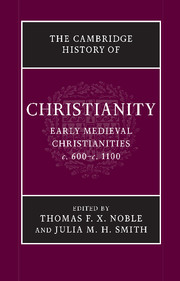Book contents
- Frontmatter
- Introduction: Christendom, c. 600
- Part I Foundations: Peoples, Places, and Traditions
- 1 Late Roman Christianities
- 2 The emergence of Byzantine Orthodoxy, 600–1095
- 3 Beyond empire I: Eastern Christianities from the Persian to the Turkish conquest, 604–1071
- 4 Beyond empire II: Christianities of the Celtic peoples
- 5 Germanic Christianities
- 6 Slav Christianities, 800–1100
- Part II Christianity in Confrontation
- Part III Christianity in the Social and Political Order
- Part IV Christianity as Lived Experience
- Part V Christianity: Books and Ideas
- Conclusion: Christendom, c. 1100
- Bibliographies
- Index
- References
1 - Late Roman Christianities
from Part I - Foundations: Peoples, Places, and Traditions
Published online by Cambridge University Press: 28 March 2010
- Frontmatter
- Introduction: Christendom, c. 600
- Part I Foundations: Peoples, Places, and Traditions
- 1 Late Roman Christianities
- 2 The emergence of Byzantine Orthodoxy, 600–1095
- 3 Beyond empire I: Eastern Christianities from the Persian to the Turkish conquest, 604–1071
- 4 Beyond empire II: Christianities of the Celtic peoples
- 5 Germanic Christianities
- 6 Slav Christianities, 800–1100
- Part II Christianity in Confrontation
- Part III Christianity in the Social and Political Order
- Part IV Christianity as Lived Experience
- Part V Christianity: Books and Ideas
- Conclusion: Christendom, c. 1100
- Bibliographies
- Index
- References
Summary
Theological identities, regional differences
Under the heading “identities,” we must ask what gave late Roman Christian communities their specific characters. We are dealing with a plural: “Christianities.” The late Roman period was, in religion as in much else, a fractured age. What lay at the root of the resulting variety? Leaders of government and church pleaded for universal loyalty – to empire and orthodoxy above all. By 600 CE, Christians found themselves nevertheless divided geographically into four main blocs. The Latin West was extensively settled by “barbarians” and strained in its relations with the East. The “Chalcedonian” church, centered on Constantinople, retained a more nuanced attachment to the Council of 451. Disaffected Christians in Egypt and western Syria, opposed to the Council, subscribed more explicitly to a “one-nature” or “miaphysite” theology. The church of East Syria distanced itself increasingly from all such preoccupations, deeply affected by its proximity to Persia and the Arabs.
It is tempting to describe and therefore explain those divisions in terms of theological dispute. Dispute there certainly was, and it was not a mere front for other principles or prejudices: the issues at stake affected the core of Christian belief and must be paid respect. The disorder and acrimony of the fifth and sixth centuries had roots reaching back at least to the Council of Nicaea (325). Arius, condemned at that council, appeared to qualify the divinity ascribable to Jesus. Forceful opponents of his position – notably Apollinarius of Laodicea (d. c. 390) – downplayed the permanence of God the Son’s humanity in the name of divine unity.
- Type
- Chapter
- Information
- The Cambridge History of Christianity , pp. 19 - 45Publisher: Cambridge University PressPrint publication year: 2008
References
- 2
- Cited by



